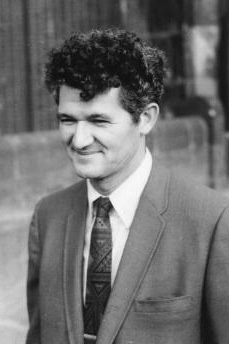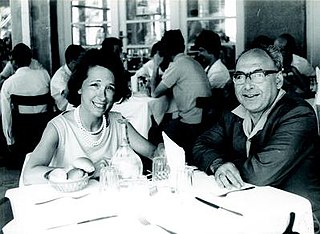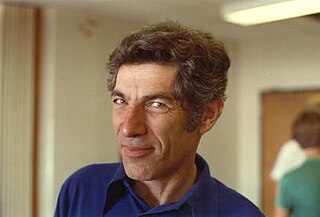Related Research Articles

Peter David Lax is a Hungarian-born American mathematician and Abel Prize laureate working in the areas of pure and applied mathematics.

Alfréd Rényi was a Hungarian mathematician known for his work in probability theory, though he also made contributions in combinatorics, graph theory, and number theory.

Frigyes Riesz was a Hungarian mathematician who made fundamental contributions to functional analysis, as did his younger brother Marcel Riesz.

Rózsa Péter, born Rózsa Politzer, was a Hungarian mathematician and logician. She is best known as the "founding mother of recursion theory".

David Harold Blackwell was an American statistician and mathematician who made significant contributions to game theory, probability theory, information theory, and statistics. He is one of the eponyms of the Rao–Blackwell theorem. He was the first African American inducted into the National Academy of Sciences, the first African American tenured faculty member at the University of California, Berkeley, and the seventh African American to receive a Ph.D. in mathematics. In 2012, President Obama posthumously awarded Blackwell the National Medal of Science.

Reuben Hersh was an American mathematician and academic, best known for his writings on the nature, practice, and social impact of mathematics. Although he was generally known as Reuben Hersh, late in life he sometimes used the name Reuben Laznovsky in recognition of his father's ancestral family name. His work challenges and complements mainstream philosophy of mathematics.

Percy John Daniell was a pure and applied mathematician.

Michael (Mihály) Fekete was a Hungarian-Israeli mathematician.
Youden's J statistic is a single statistic that captures the performance of a dichotomous diagnostic test. (Bookmaker) Informedness is its generalization to the multiclass case and estimates the probability of an informed decision.
Florence Nightingale David, also known as F. N. David was an English statistician. She was head of the Statistics Department at the University of California, Riverside between 1970 – 77 and her research interests included the history of probability and statistical ideas.
José-Miguel Bernardo Herranz is a Spanish mathematician and statistician. He is a noted Bayesian and known for introducing the concept of reference priors.

Gábor J. Székely is a Hungarian-American statistician/mathematician best known for introducing energy statistics (E-statistics). Examples include: the distance correlation, which is a bona fide dependence measure, equals zero exactly when the variables are independent; the distance skewness, which equals zero exactly when the probability distribution is diagonally symmetric; the E-statistic for normality test; and the E-statistic for clustering.

Patrick Paul Billingsley was an American mathematician and stage and screen actor, noted for his books in advanced probability theory and statistics. He was born and raised in Sioux Falls, South Dakota, and graduated from the United States Naval Academy in 1946.
István Vincze was a Hungarian mathematician, known for his contributions to number theory, non-parametric statistics, empirical distribution, Cramér–Rao inequality, and information theory. Considered by many, as an expert in theoretical and applied statistics, he was the founder of the Mathematical Institute of the Hungarian Academy, and was the Head of the Statistics Department. He also held the post of professor at Faculty of Science of the Eötvös Loránd University. He wrote over 100 academic papers, authored 10 books, and was a speaker at several conferences, including the Berkeley Symposiums in 1960, 1965, and 1970. He received honors and awards like the Hungarian State Prize and Grauss Ehrenplakette in 1966 and 1978 respectively.
Grace Elizabeth Bates was an American mathematician and one of few women in the United States to be granted a Ph.D. in mathematics in the 1940s. She became an emeritus professor at Mount Holyoke College. Bates specialized in algebra and probability theory, and she co-authored two textbooks: The Real Number System and Modern Algebra, Second Course. Throughout her own education, Bates overcame obstructions to her pursuit of knowledge, opening the way for future women learners.

Pao-Lu Hsu or Xu Baolu was a Chinese mathematician noted for his work in probability theory and statistics.

Alice Guionnet is a French mathematician known for her work in probability theory, in particular on large random matrices.
Ilona Palásti (1924–1991) was a Hungarian mathematician who worked at the Alfréd Rényi Institute of Mathematics. She is known for her research in discrete geometry, geometric probability, and the theory of random graphs. With Alfréd Rényi and others, she was considered to be one of the members of the Hungarian School of Probability.
Elena Anne Corie Marchisotto is a mathematician, mathematics educator, and historian of mathematics. She is a professor emeritus of mathematics at California State University, Northridge.
References
- 1 2 "Paid Notice: Deaths BERGER, AGNES P." The New York Times. 2002-03-29. ISSN 0362-4331 . Retrieved 2020-04-24.
- ↑ Sneha, Narayan (2011). Making it in the mathematical community: the case of women mathematicians in Hungary (Master of Arts). Central European University. p. 34.
- ↑ Hersh, Reuben; John-Steiner, Vera. "A Visit to Hungarian Mathematics" Archived 2013-06-27 at the Wayback Machine . The Mathematical Intelligencer15 (2): 13-26. Retrieved 26 March 2017.
- ↑ Hersh, Reuben (2014-12-29). Peter Lax, Mathematician. American Mathematical Soc. ISBN 978-1-4704-1708-6.
- ↑ Mintzis, Matthew J.; Berger, Agnes P.; Greenwald, Edward; Greenwald, Edith; Golomb, Frederick (1978). "Malignant melanoma in spouses". Cancer. 42 (2): 804–807. doi: 10.1002/1097-0142(197808)42:2<804::AID-CNCR2820420254>3.0.CO;2-9 . ISSN 1097-0142. PMID 679166. S2CID 31381862.
- ↑ Golbeck, Amanda L. (2017-04-28). Equivalence: Elizabeth L. Scott at Berkeley. CRC Press. ISBN 978-1-351-75191-9.
- ↑ Fleiss, Joseph L.; Levin, Bruce; Paik, Myunghee Cho (2013-06-12). Statistical Methods for Rates and Proportions. John Wiley & Sons. ISBN 978-1-118-62561-3.